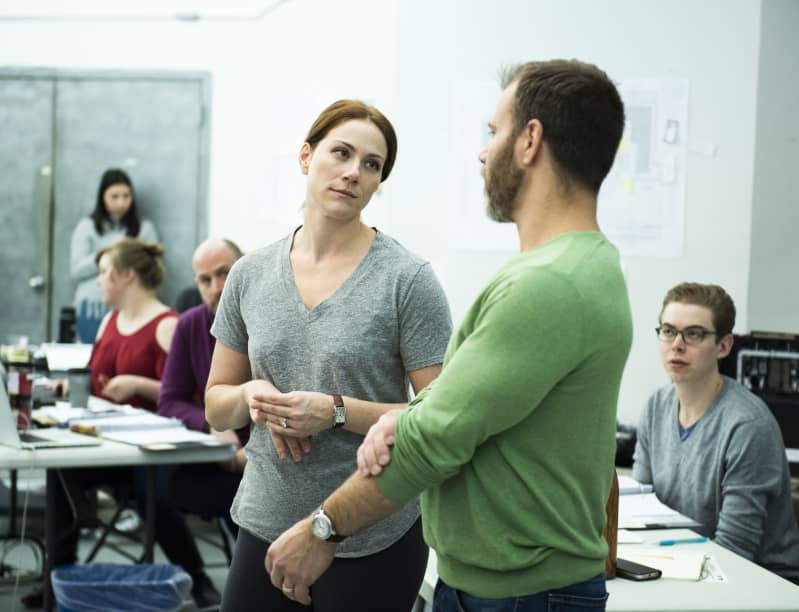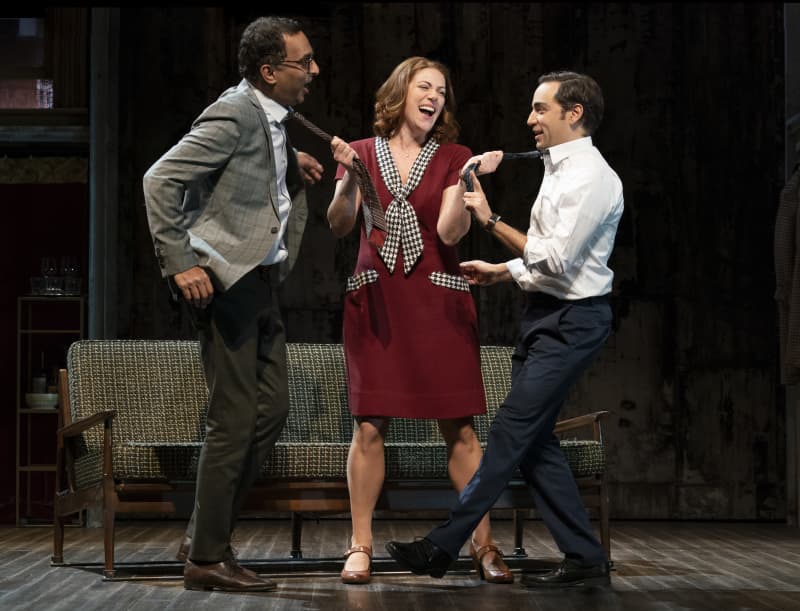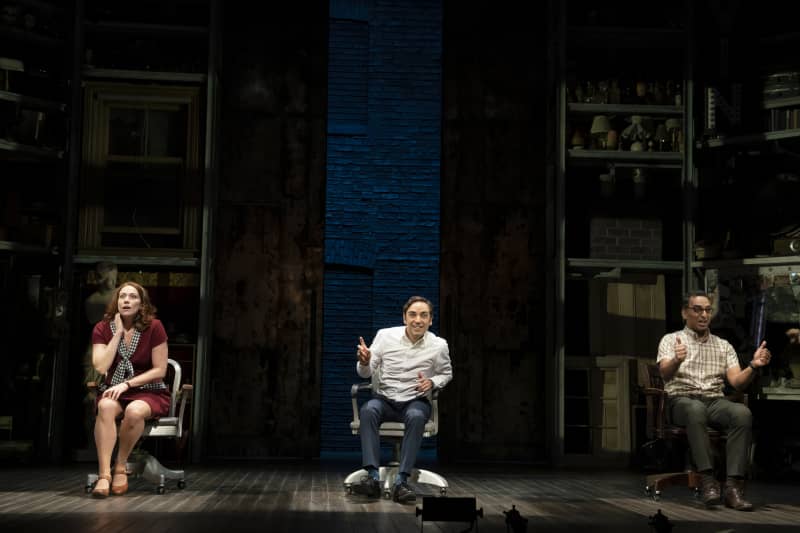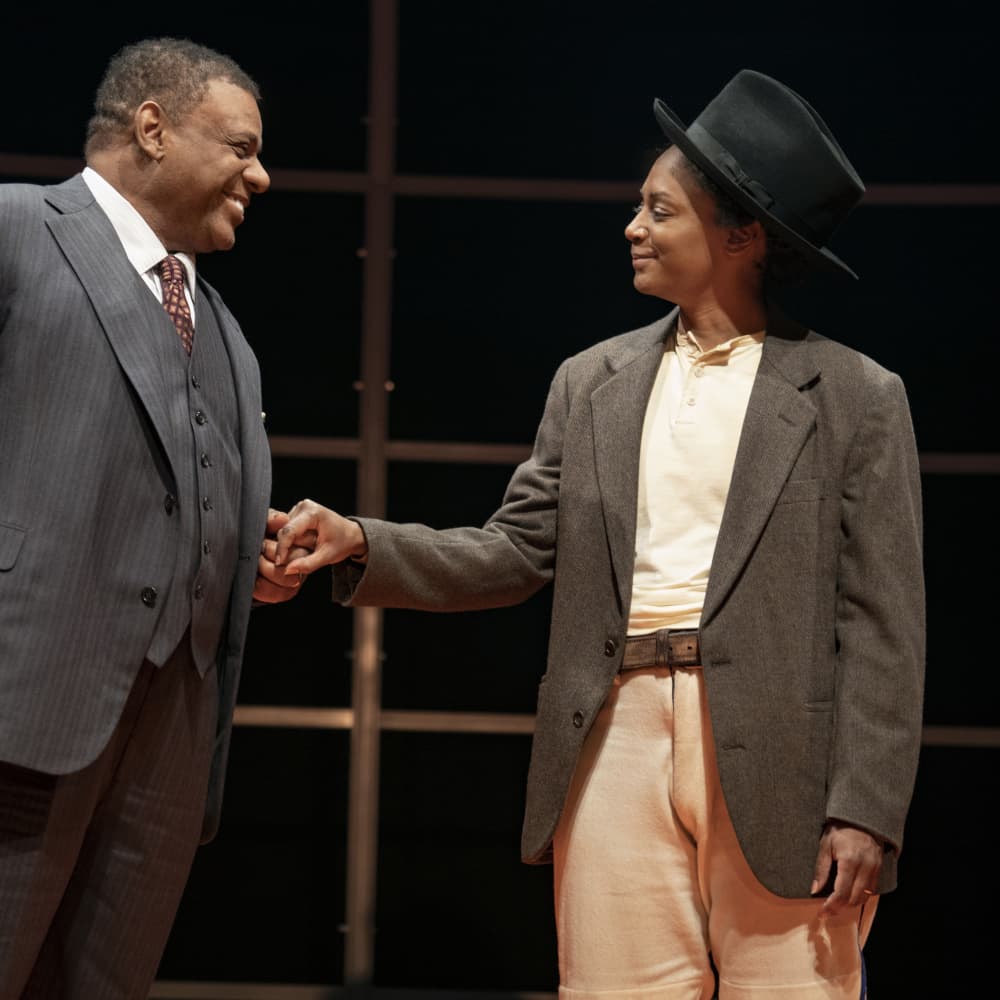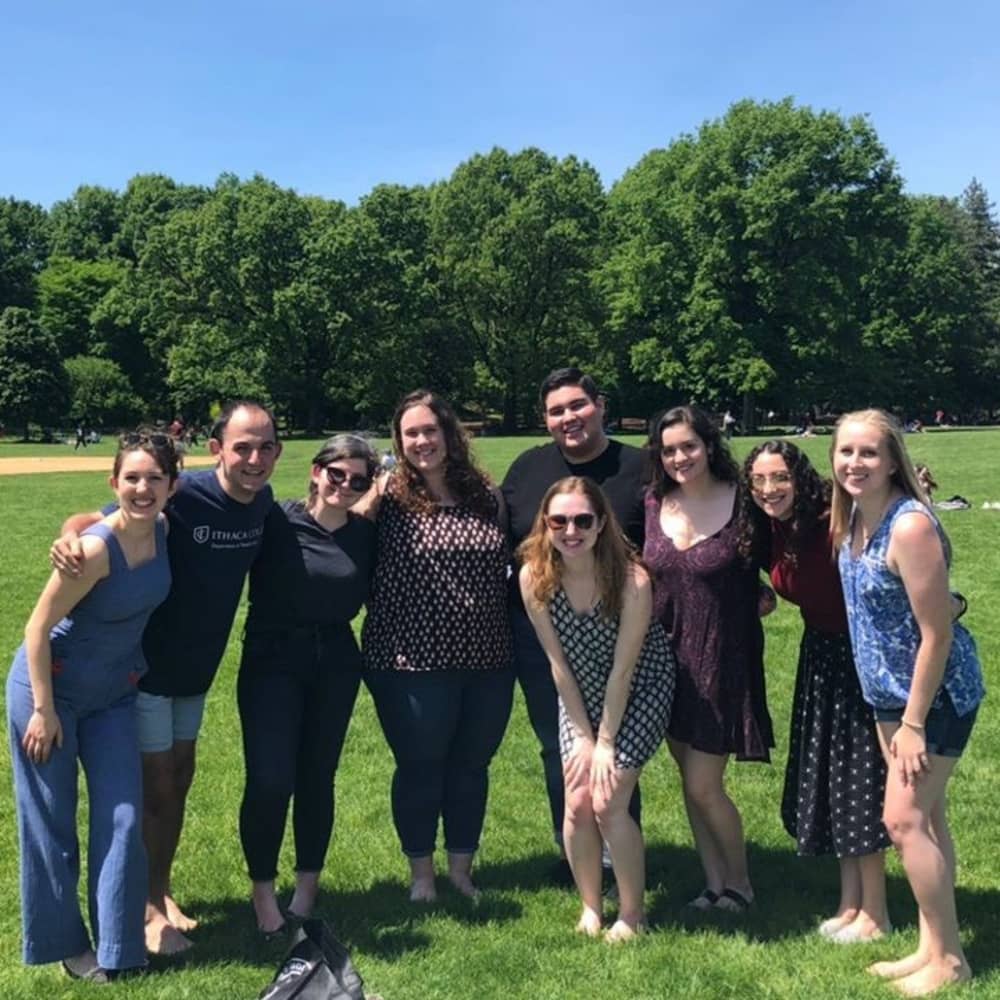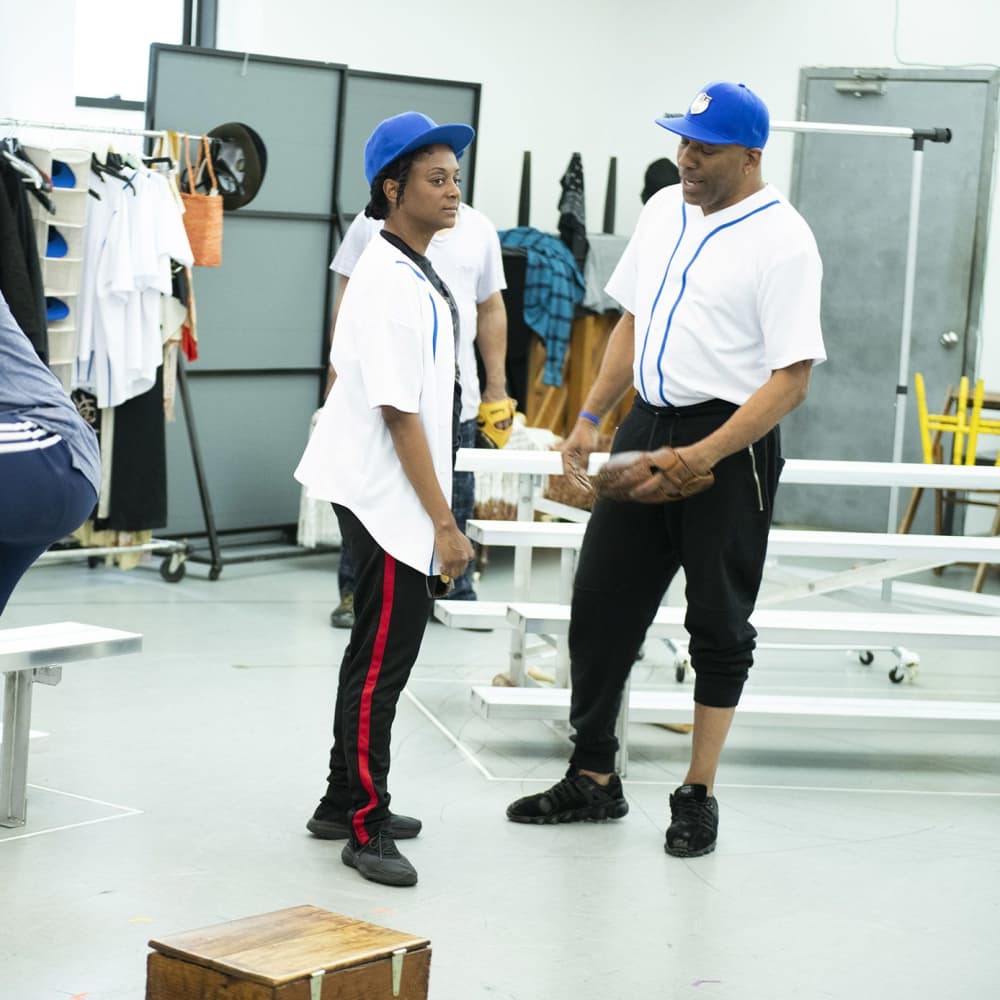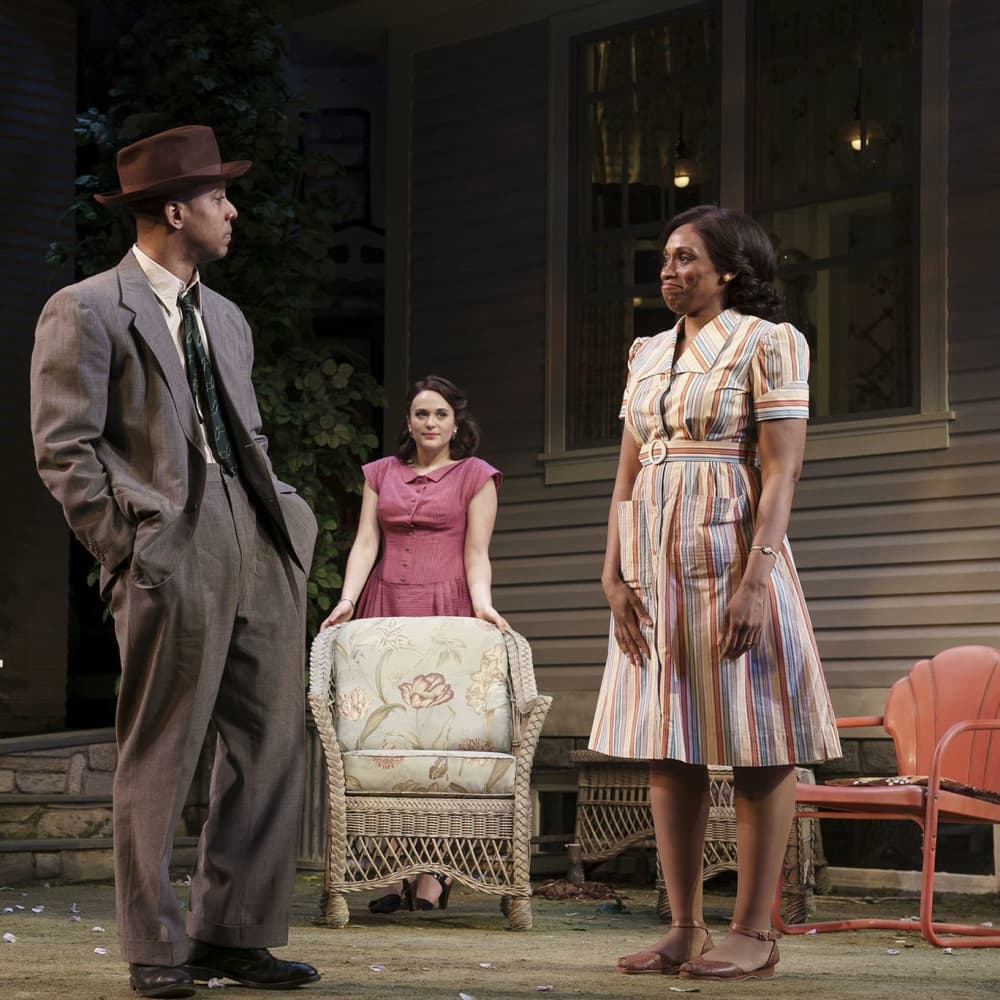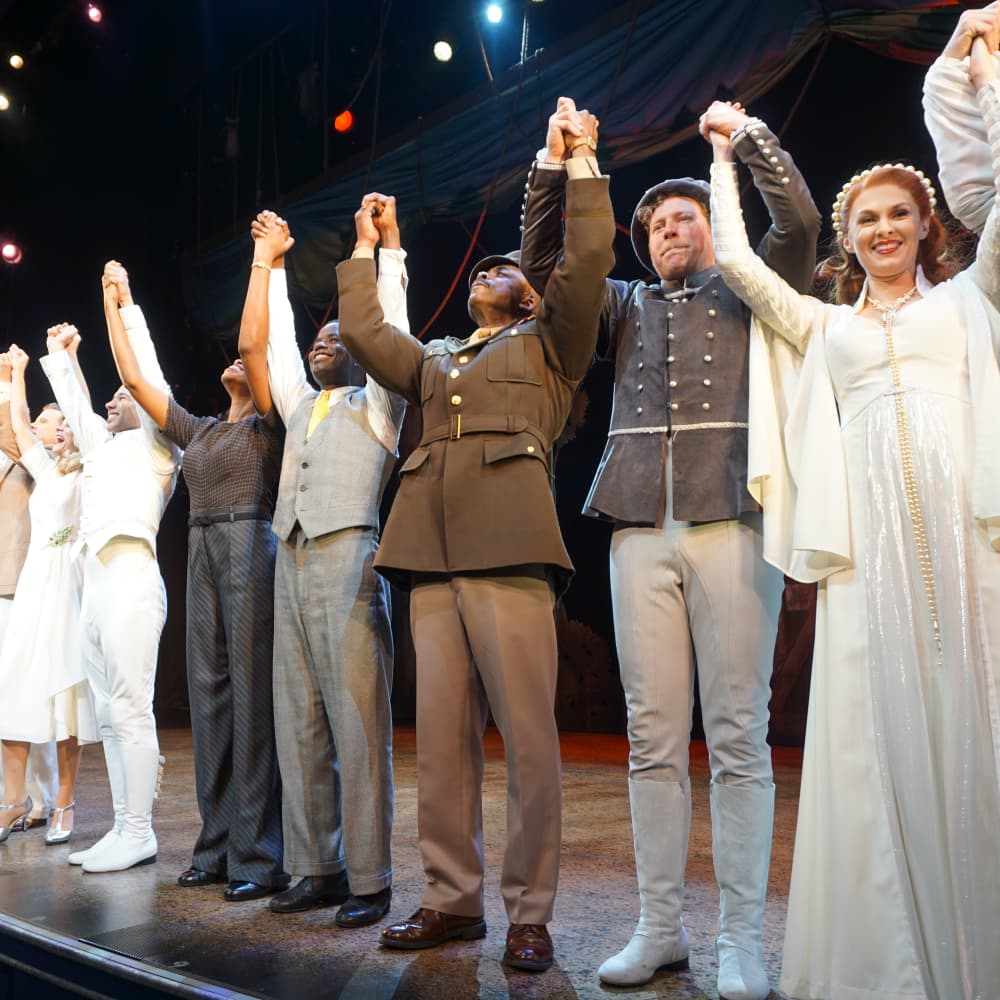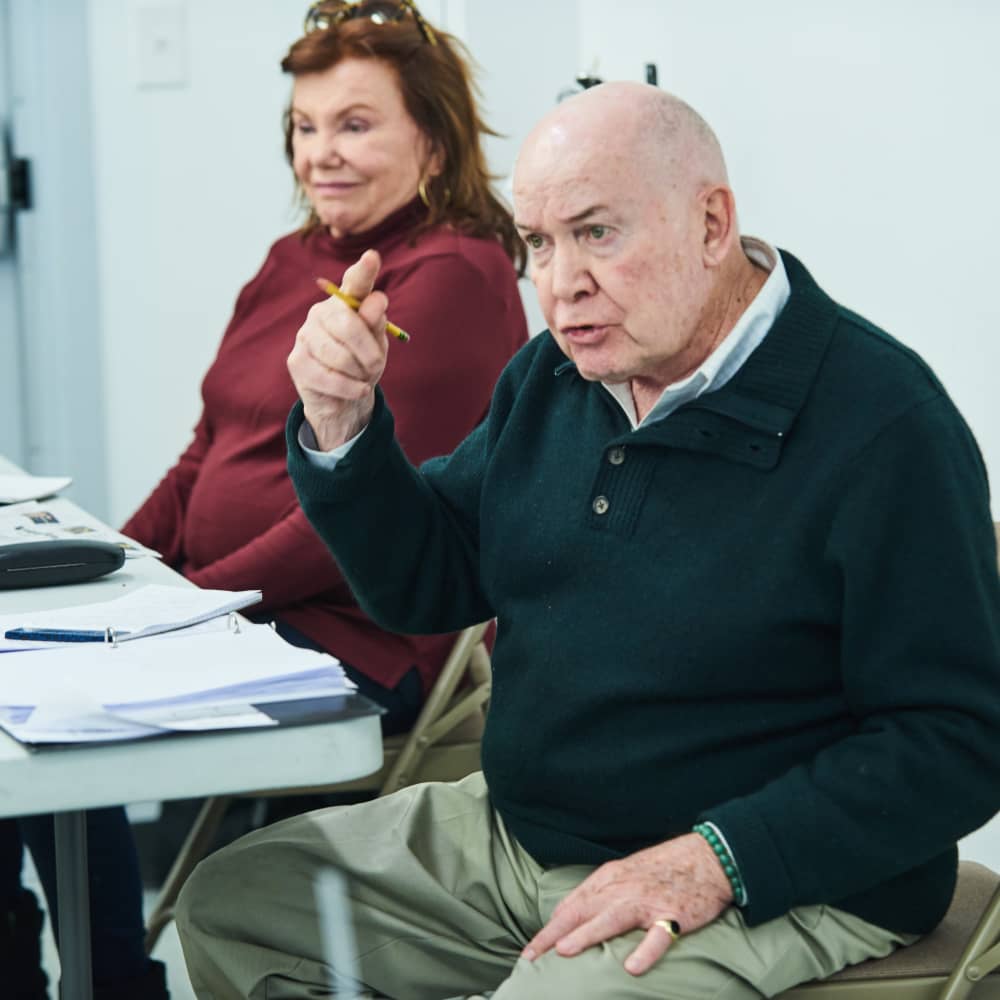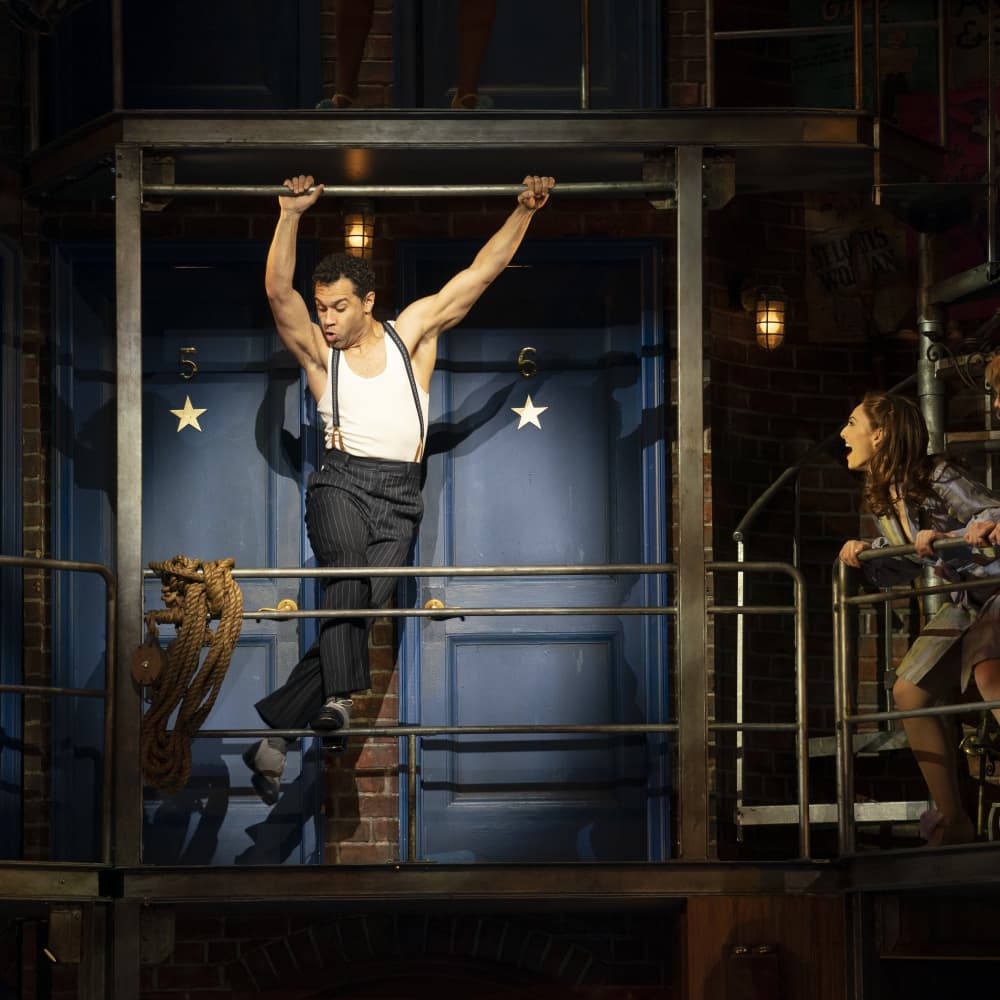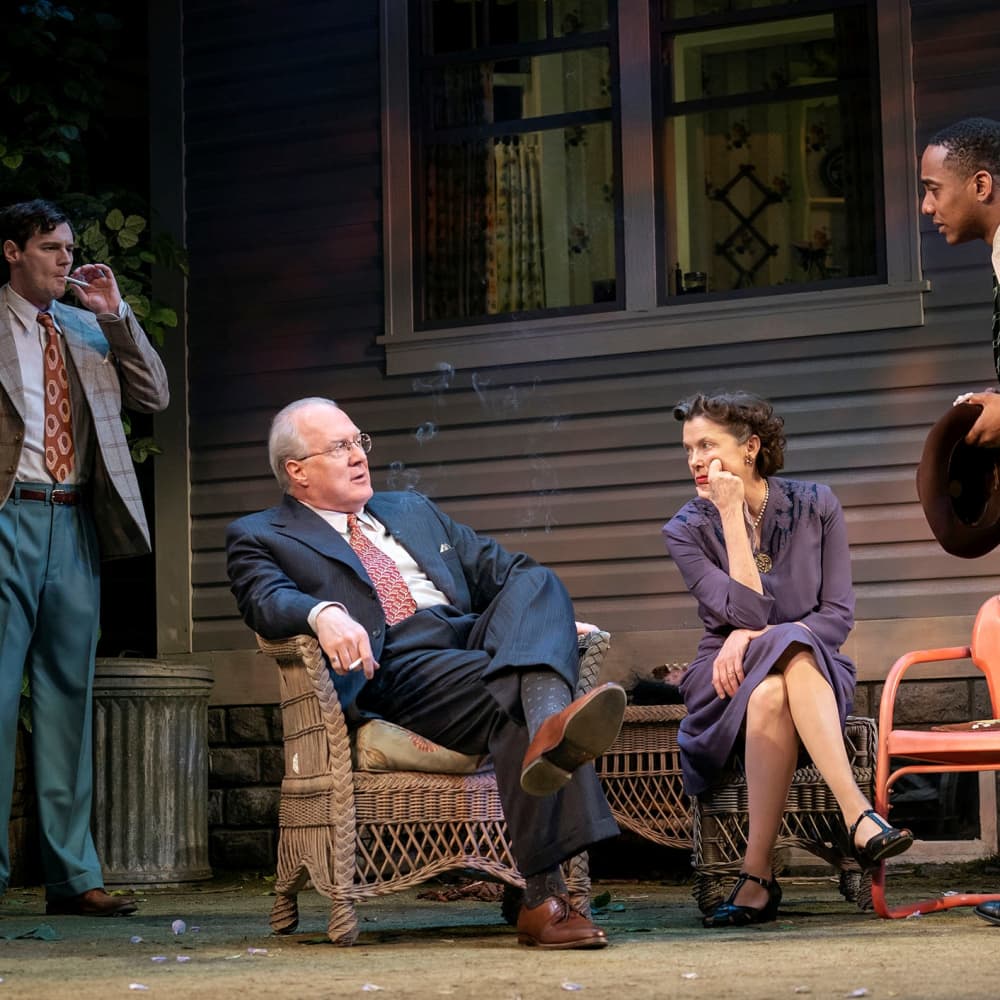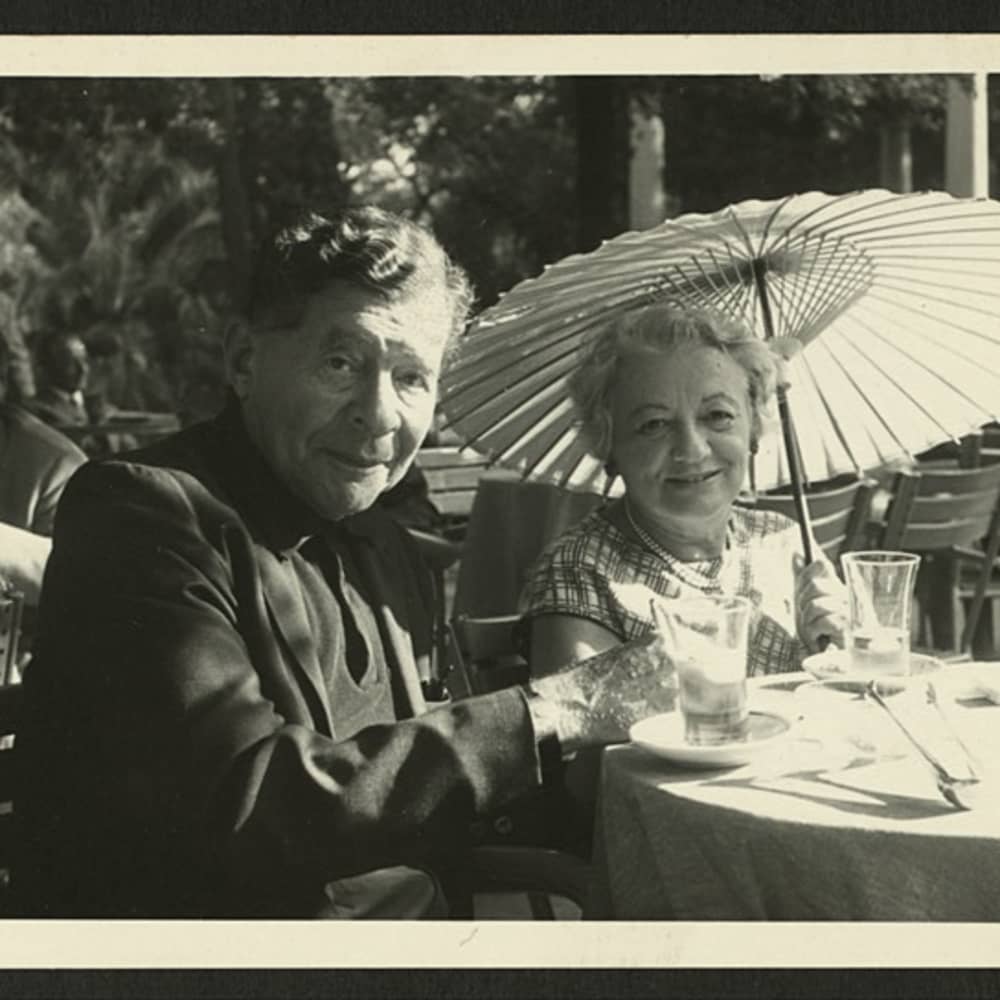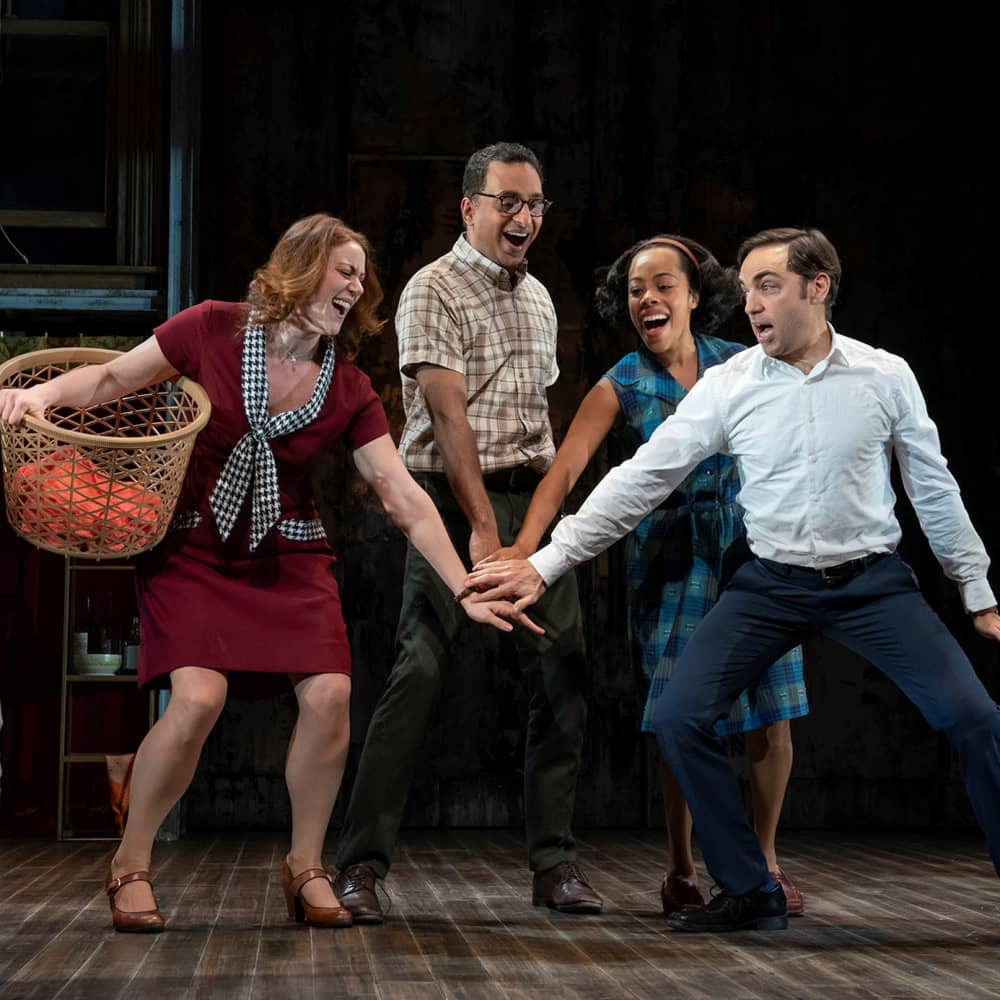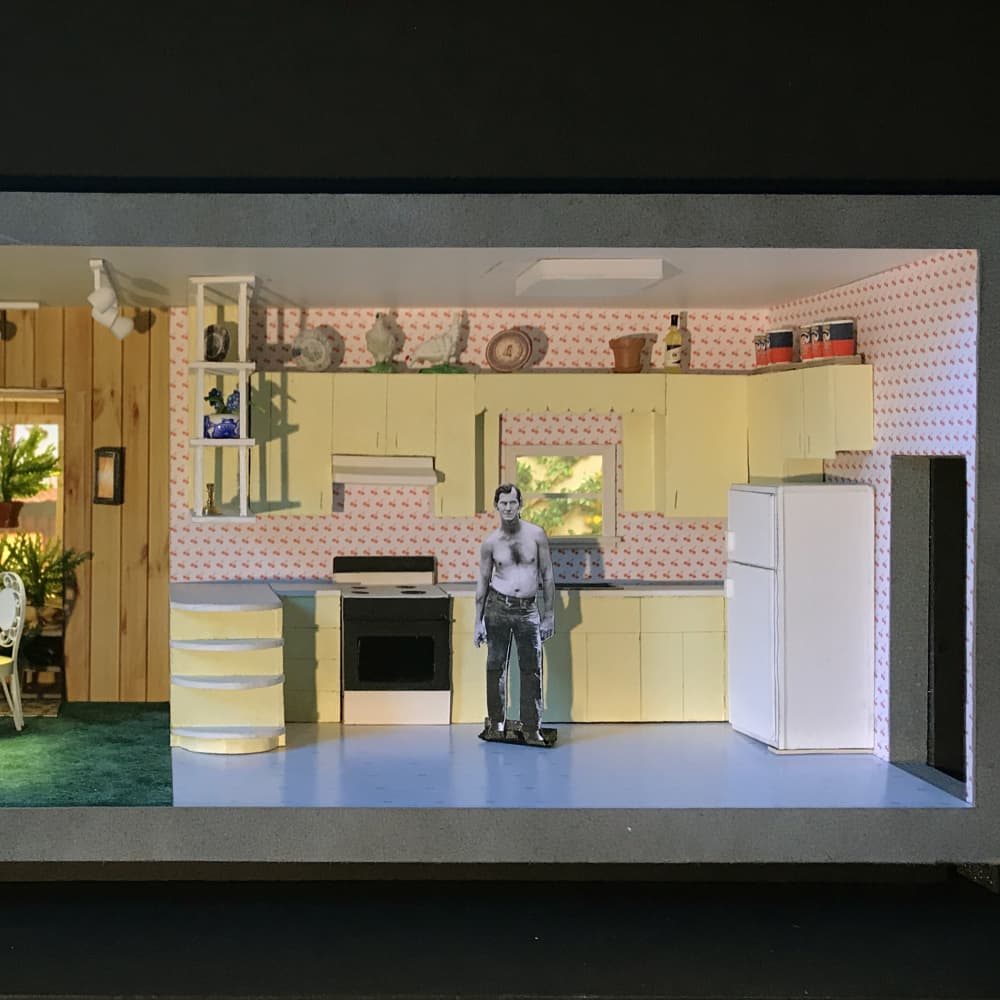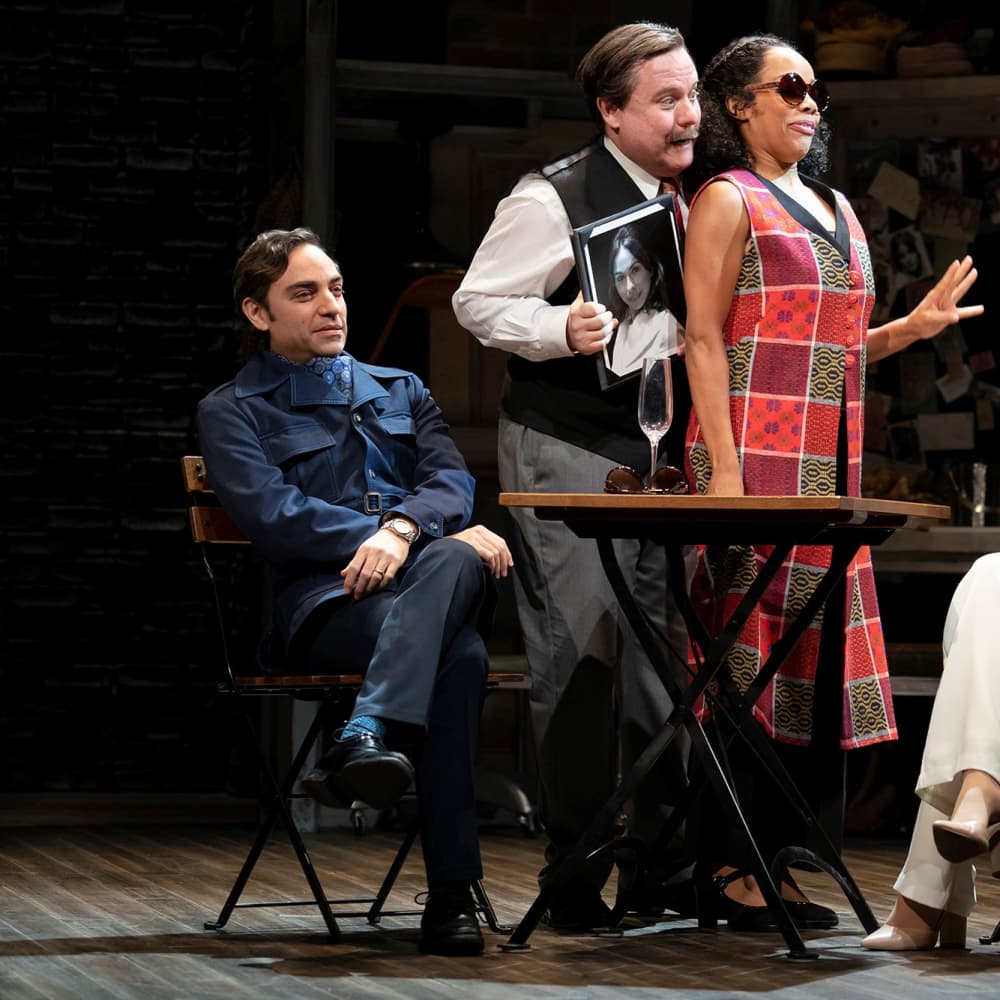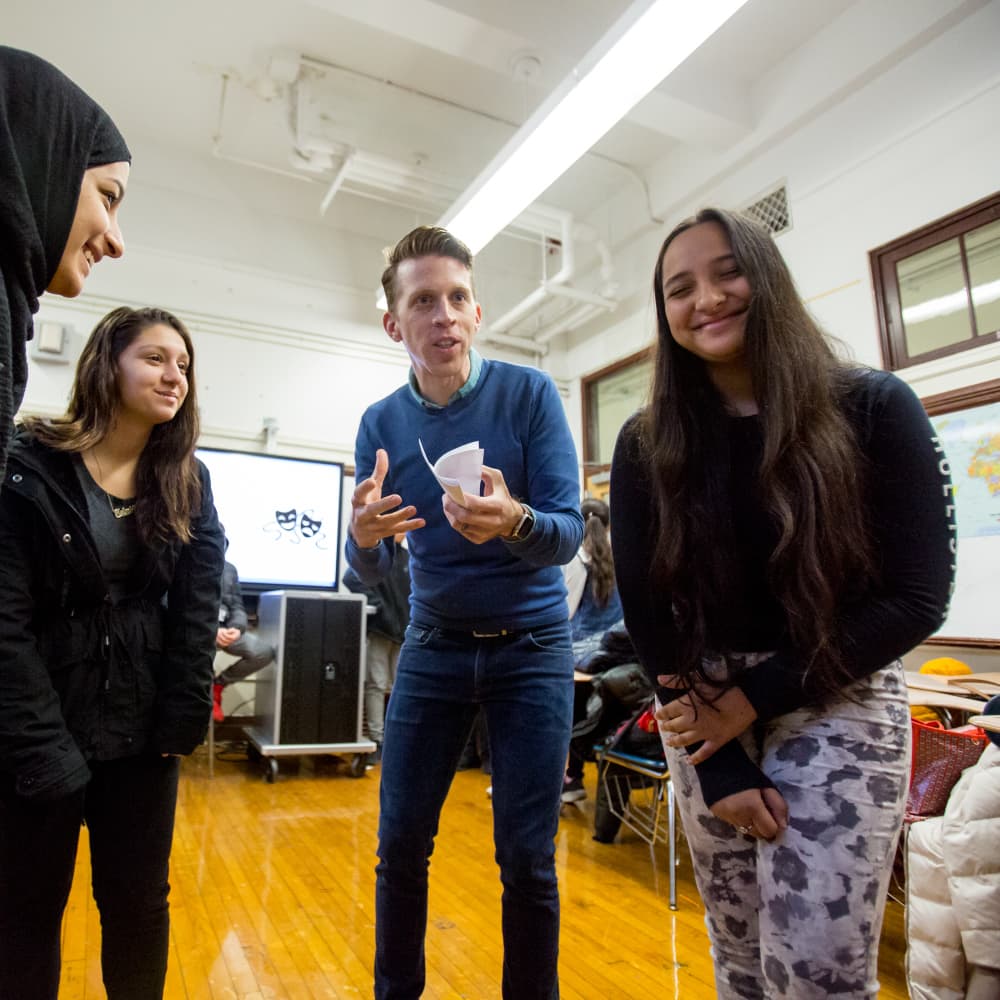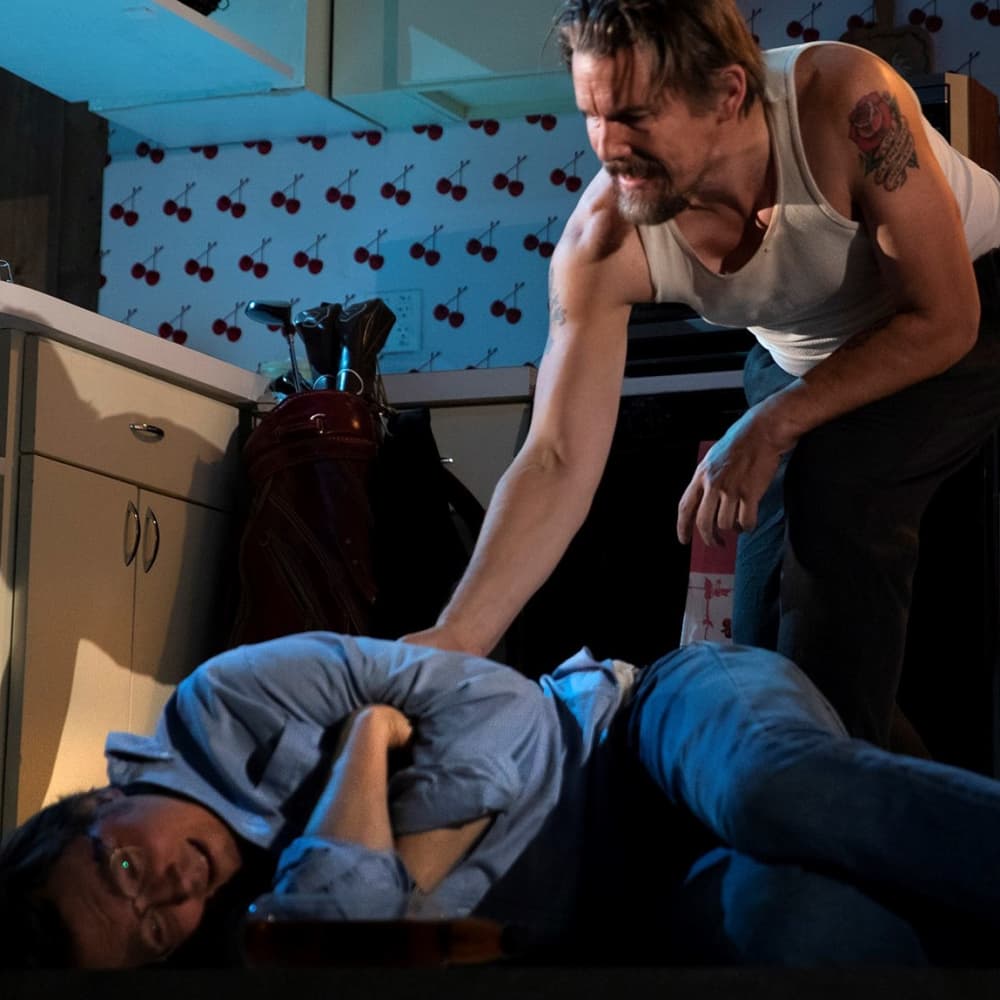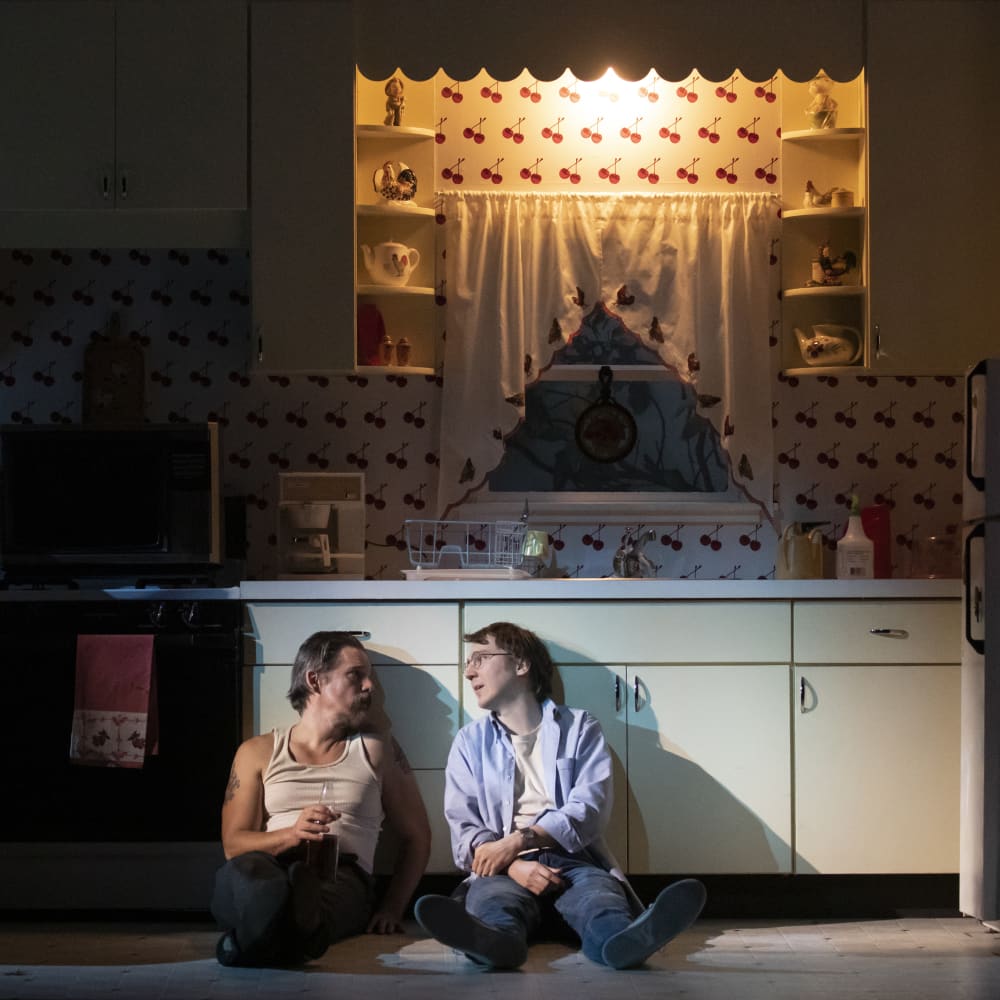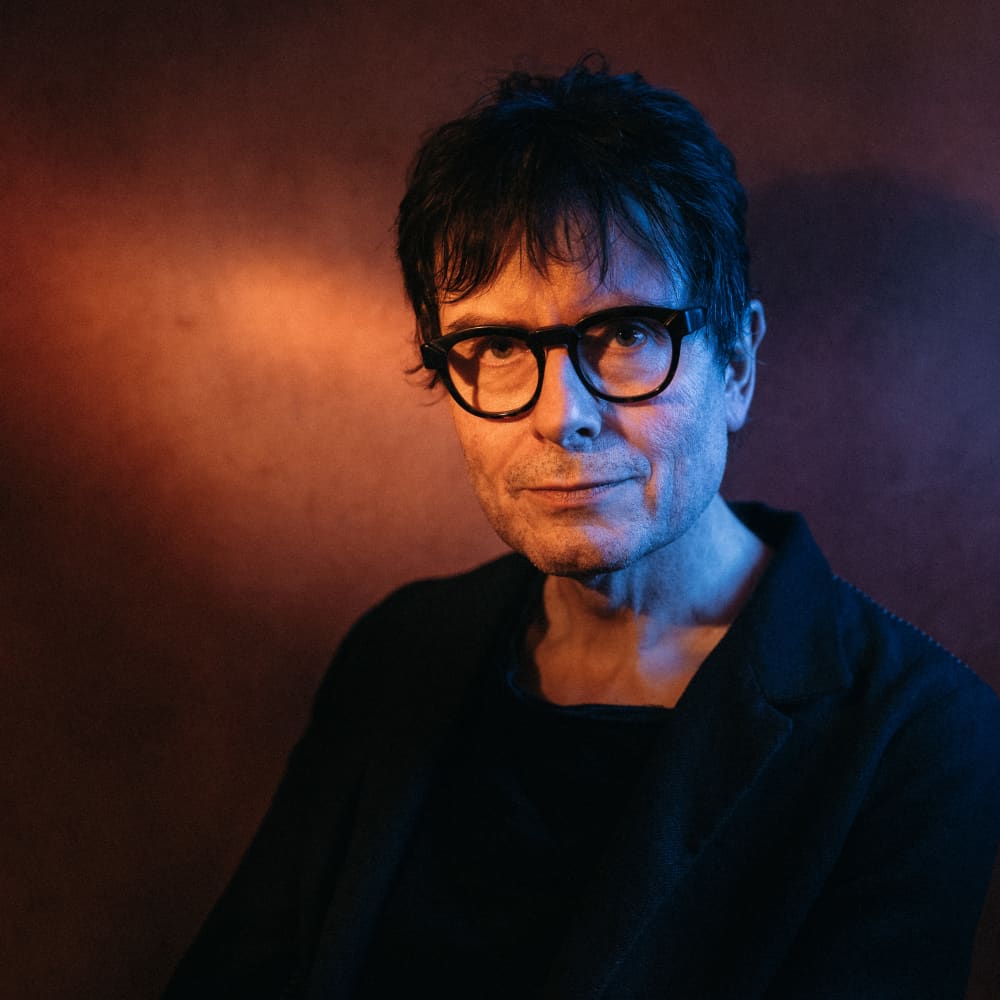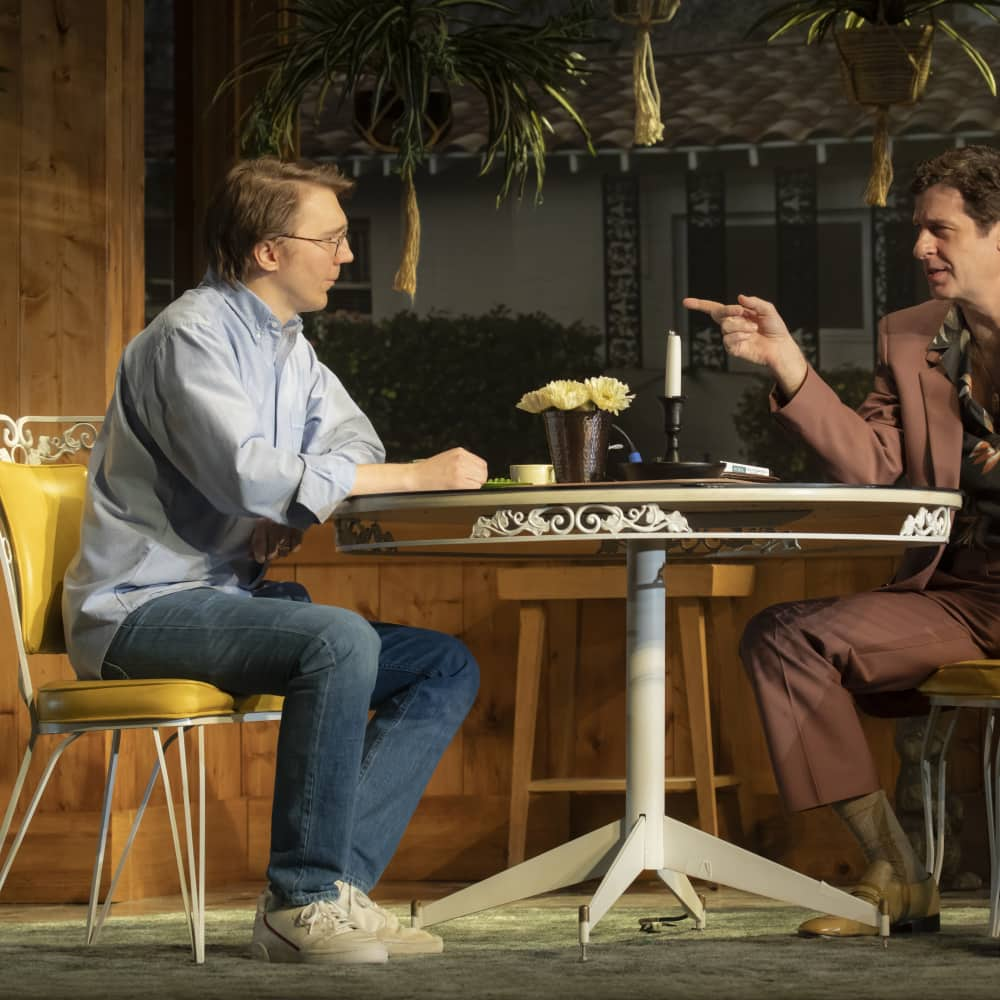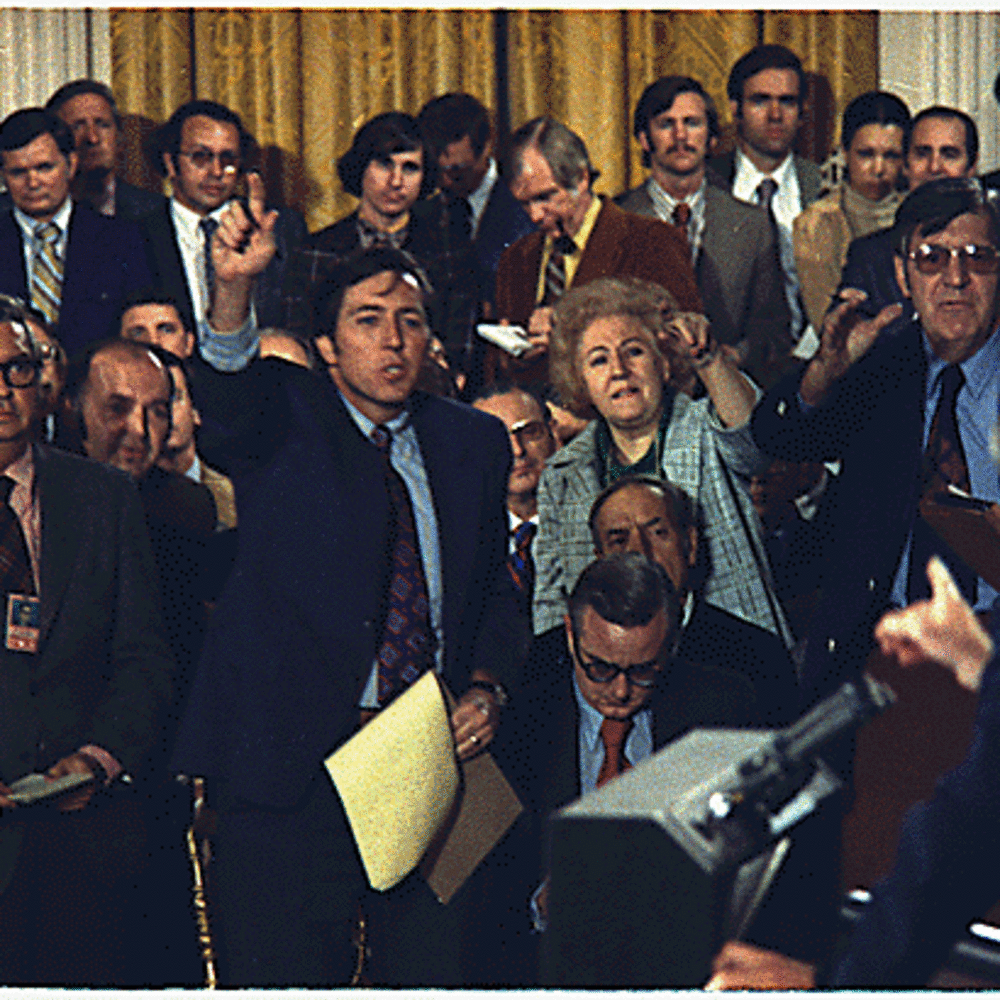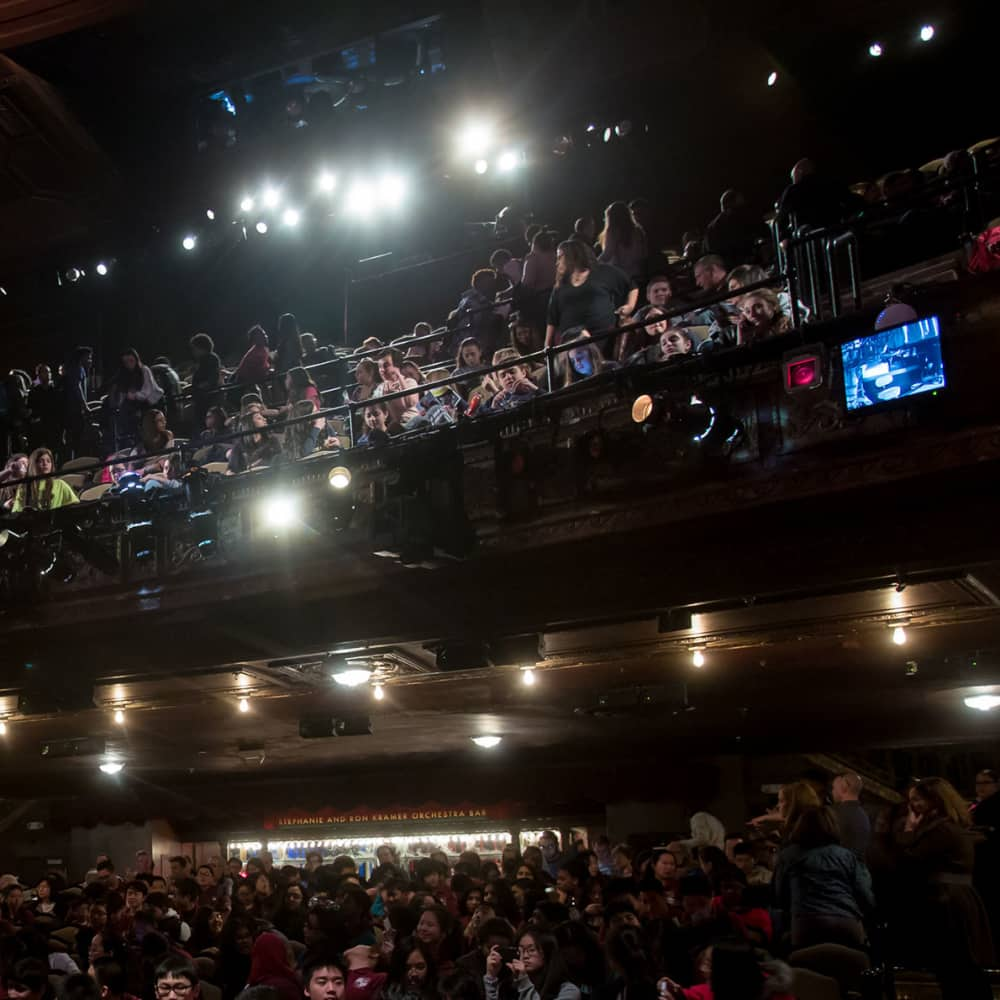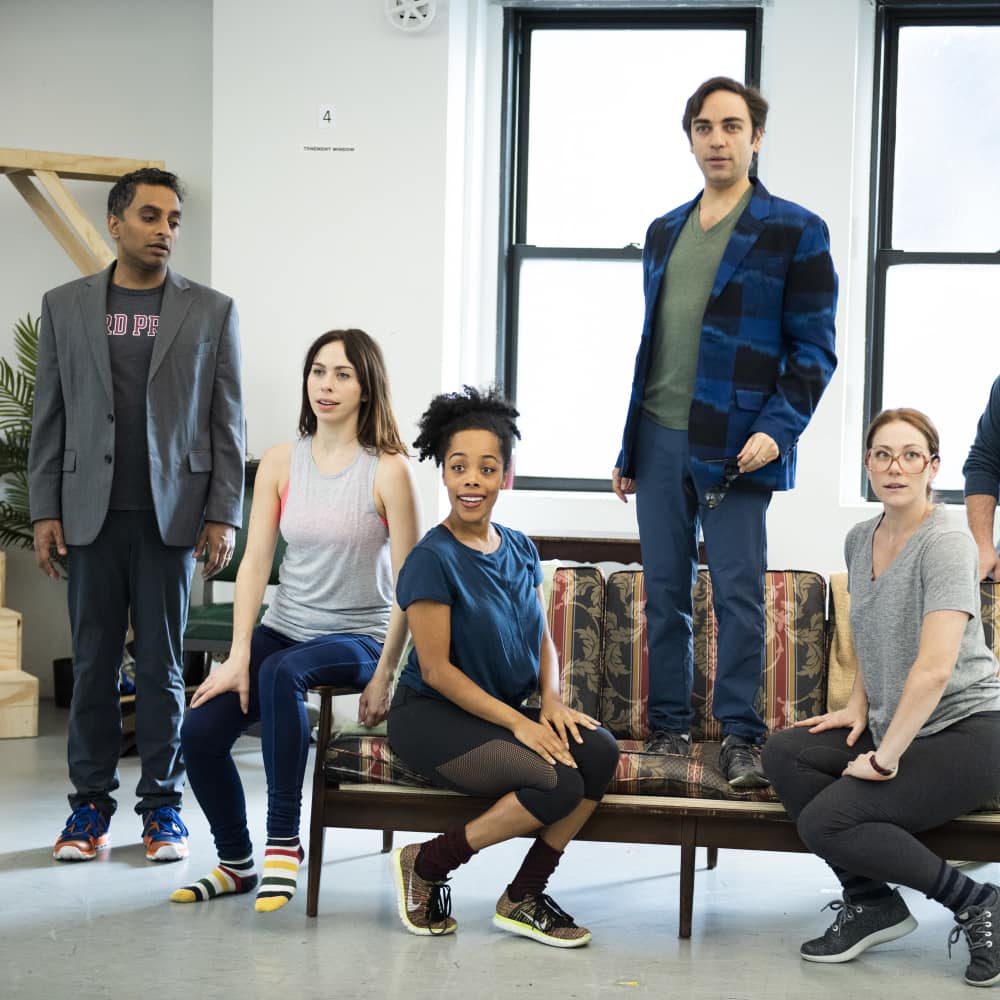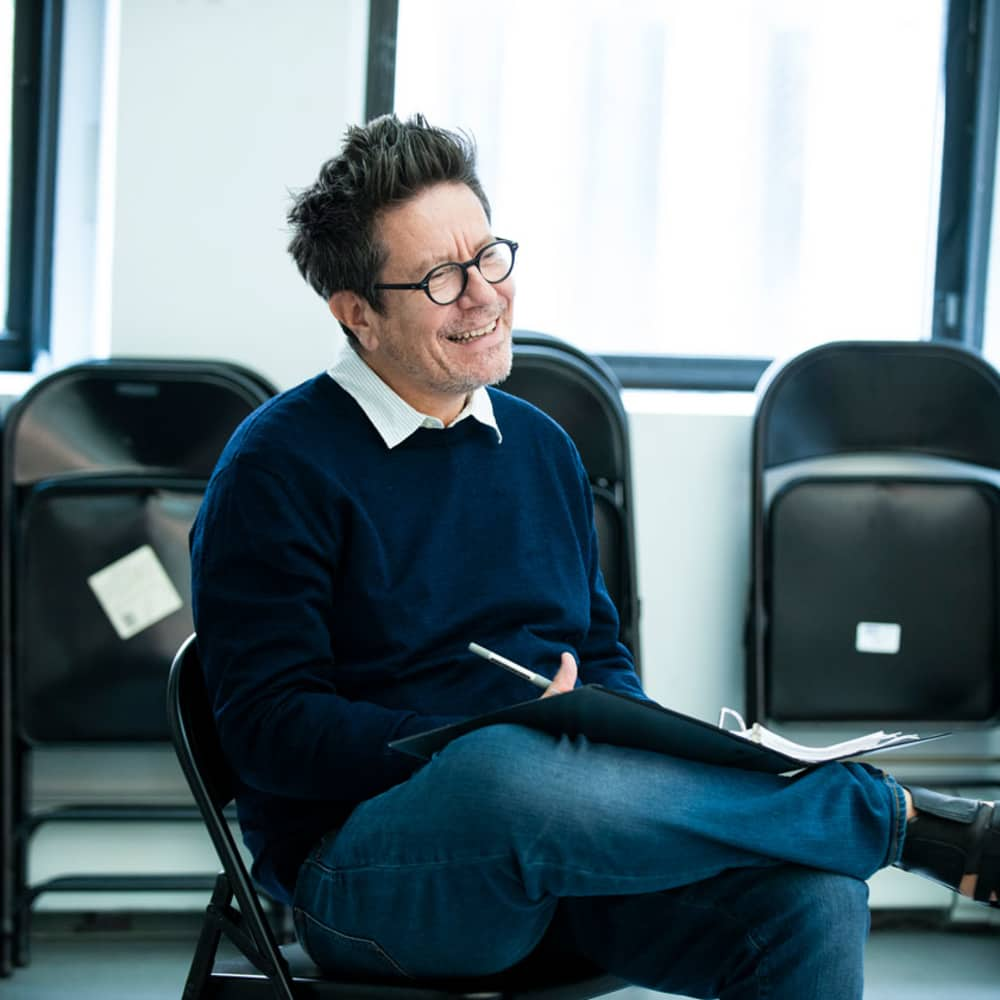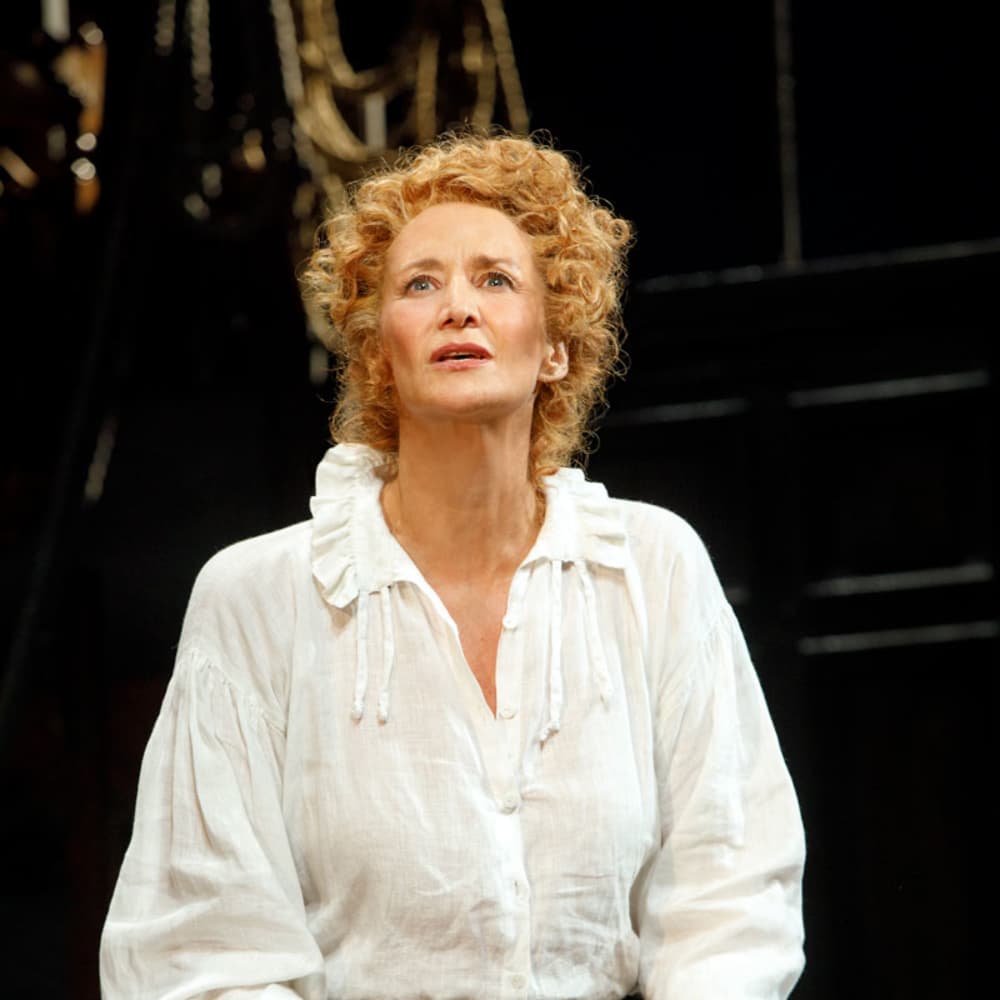Merrily We Roll Along :
Interview with Fiasco's Jessie Austrian and Ben Steinfeld
Posted on: February 13, 2019
Fiasco Theater, an ensemble theater company created by graduates of the Brown University/Trinity Rep M.F.A. acting program, has the mission of offering dynamic, joyful, actor-driven productions of classic and new plays, as well as high-level theatrical training through classes and workshops. Their breakout production of Shakespeare’s Cymbeline was presented Off-Broadway twice, for nearly 200 performances, and was honored with the 2012 Off-Broadway Alliance Award for best revival. Fiasco’s production of Into the Woods at Roundabout garnered the 2015 Lucille Lortel Award for Best Revival.
Education Dramaturg Ted Sod spoke with two of Fiasco Theater’s co-artistic directors, Jessie Austrian and Ben Steinfeld, about their work on Merrily We Roll Along.
Ted Sod: Will you start by telling us what each of your roles is in Fiasco Theater, and in this version of Merrily We Roll Along?
Jessie Austrian: I am one of the co-artistic directors of Fiasco and have been part of conceptualizing and script-weaving Fiasco’s Merrily since we first looked at it in a workshop a couple years ago. And I play Mary Flynn.
Ben Steinfeld: I’m one of the co-artistic directors of Fiasco Theater. I worked on the new version of the script and concept with Jessie and Noah Brody [Fiasco’s third co-artistic director and director of Merrily], and I play Frank Shepard in the show.
TS: Will you talk about being company in residence at Roundabout Theatre Company? Why was that a choice you all made for Fiasco?
JA: It’s a huge gift to be in residence at RTC. RTC’s contribution to Fiasco as a company in residence helps us to stay in town and develop work we’re passionate about, while attempting to pay our artists a living wage. Our early workshops [of Merrily] varied wildly and sometimes missed the mark entirely, but RTC’s faith in us to say “keep working on it” let us learn from those failed experiments and keep working on it until we found the most useful approach.
TS: What went into the decision process before you all said yes to Merrily We Roll Along being Fiasco’s follow-up musical to your successful version of Into the Woods? Will you talk about why you personally thought it important to produce this show? What would you say it is about?
BS: So much of our Fiasco journey as artists has been about dealing with questions of what it means to be old friends who want to make art together. And that’s what Merrily is about! So it seemed to us that we were in a unique position to bring our experiences and imaginations to the story. And any chance to continue collaborating with Stephen Sondheim is something that any of us would jump at any time. I think this show is about what happens to relationships when the people in those relationships change.
JA: It was a brilliant suggestion from Todd Haimes and Jill Rafson for Fiasco to look at this show. It’s about three friends and collaborators dealing with how their relationships, dreams, artistry, and feelings change over time…we know a little bit about that and could bring ourselves to it. On one level, it’s about the power of a friendship and collaboration and what gets lost when individual needs, ego, fear, desire, and thoughtlessness get in the way. Fiasco is a group of six artists who have thrown our lot in together: we’ve opened a lot of doors together because of how we work collectively. It’s a cautionary tale for us to remember how important that is and what kind of care it takes to grow together over time—that’s not easy.
But here’s what it’s really about for me: it’s about how the younger versions of ourselves still exist within us at every age, and young people’s voices have something to teach us at every age. A line that we reinstated from the 1981 script is: “We are all somewhere, way down deep, 18 all our lives, because that is the age when everything is possible.” It’s not too late to reconnect to your 18-year-old dreams, passion, love, and beautiful naivety. There’s something magical as an actor in getting to take the journey back to being 18 over the course of the show, a reenactment in order to learn something from the past. It’s almost religious. And right now, in this political moment I think it’s very important to tell a story that says: listen to young people.
Because we were given all the previous drafts of the show, we were able to look back at the younger versions of the script. You can better understand how something “got to be here” by looking at its earlier drafts. The more time we spent with it, we found we really loved some of the material from the 1981 version that was cut and changed in later drafts. We wanted to bring out the passion, fun, and the let’s-put-on-a-show-energy that infused the 1981 script. We found valuable material in the younger drafts.
TS: Will you all talk about your relationship with Stephen Sondheim? What have you learned about him as an artist, and from him as a human being?
JA: He’s as generous and brilliant as you can imagine. It’s been a gift to have conversations about the piece with him and learn from his experience with the show over the last 35 years. When we first told him we were interested in exploring the show, he gave us all the archival materials (earlier drafts, cut songs, etc.) from 1981, and that’s what really informed the process and this production. He models the line I mentioned above: he has not forgotten or written-off his 18- year-old self. That 18-year-old self is very much in conversation with his current self. He brings his experience to every conversation without an ounce of jadedness or immovability. He has clear ideas and opinions but is always intently listening to other ideas. He is endlessly curious and gives his collaborators the benefit of the doubt. It’s extraordinary but not surprising that someone whose work is this inspired also inspires in his process as an artist and a human.
BS: Well, something that sometimes needs to happen when you encounter your heroes is to remember that they are, in fact, both artists and human beings. Stephen’s humor, openness, creativity, intellectual fire, and down-to-earth honesty have taught me that, in many ways, we are all on the same journey as theatre artists—trying to do the thing that we think matters and wanting other people to care about it. He has also taught me that all art is a form of teaching.
TS: Describe your process developing this version of the show. How have you drawn upon earlier versions of the story (including the original source material by Kaufman and Hart) to come up with this iteration? How did you arrive at the approach you used? What cracked it open for you during your developmental workshops?
JA: With the estates’ blessings, we worked from four versions of the script: the current licensed version (copyright 1994, 1987), the 1981 opening night draft, the 1981 rehearsal draft, and the original 1937 Kaufman and Hart play. We did four workshops over a couple of years. They varied wildly; early on we experimented with it being a total memory play with no transitions or references to years at all, which was interesting as part of our process but ultimately not useful. It was when we really focused the show on the relationship between Frank, Mary, and Charley as the launching point for the rest of the show that things started to crack open. We had experimented with slightly larger cast sizes in different workshops (up to 10 people) but ultimately found it most potent with six: the triangle of Mary, Frank and Charley plus the triangle of people who interweave with their friendship most over the years: Beth, Gussie, and Joe. Around the same time, we had a crackling meeting with our set designer, Derek McLane, in which he proposed the wonderful idea of the space being a sort of prop/costume warehouse. It’s a show about people in the entertainment industry, so doing it with only six cast members in a space where you can grab a wig off a shelf to play “that guy at that party in 1960” got us very excited, mostly because it sounded FUN. Yes, this show is about the challenges of growing up and growing apart from people you love, but it’s also got a ton of fun baked into it. The thing we loved most about the 1981 drafts was how much fun they were: the initial concept was literally kids putting on a show in the high school gym. Derek’s space and only six actors got at that same spirit in a way that we knew would be fun and rewarding for Fiasco and hoped would be as fun and rewarding to the audience.
TS: This musical is famously told in reverse chronology—what are the challenges of presenting a play whose storytelling is backwards?
JA: I don’t really think it’s a huge challenge. It’s like looking at a photo album in reverse: you recognize the people, and perhaps it can be a beautiful experience to seem to see time go backward, which of course it never can in life. Furth and Sondheim wrote a piece of experimental theater in 1981, and we’ve tried to honor that, rather than trying to make the show conform to a kind of dramaturgy that isn’t what the show is trying to do. We have tried to take the pressure off of the years to mean something specific to the audience (since audiences of varying ages will have different relationships to hearing “1973” anyway). A scene in this play happens in 1973 because that’s the year these friends had that specific argument, not because the play is saying something about America in 1973, specifically. It’s about these human beings and where their relationships were at points over the course of 25 years. The particular years aren’t the point; it’s about the broader idea of people and circumstances changing over time.
BS: I’ve come to think that the real challenge of a story on stage that goes backwards is that, as an actor, you have to figure out somehow how your experience of the play can accumulate, move forward, and grow as the show goes on. In a linear show, this happens automatically, since the characters know more at the end than at the beginning. But in Merrily, it’s the opposite. As an actor, however, I don’t want to cut short my experience of growth and the richness of accumulating the story—so that’s the challenge. But the writing in this piece, and the staging/acting of our production, makes building a rich experience in real time both possible and fun.
TS: How does a company who had their first breakthrough hit doing Shakespeare end up doing Sondheim? What are the similarities in performing or directing works by both authors? What are the challenges, and what are the profound differences?
JA: They are both masters at putting human experience into language and sound. They work very similarly in that sense—if you unpack what is the human experience that Shakespeare or Sondheim is after in this moment, and let the form (verse, rhythm, style) work in tandem with the content, basically all you have to do as an actor is let it in and have the experience. The writers have done all the work for me; I just have to open my heart, let it in, and be a vessel for their genius.
TS: This is a musical about three friends. How has working on it affected your own friendships and/or working relationships? What is the most salient thing—so far—that you have each learned about yourselves by working on this musical?
BS: Like the characters in the piece, and like the original creators of the show, the three of us have had our ups and downs with this process over the last couple of years. But I’m proud of the fact that we have moved through those conflicts and confusions and come out the other side with something to be really proud of—both personally and artistically. It has helped us with growing up. So far, the thing that I’ve learned about myself working on the show, more than anything else, is that I’ve always really wanted to be a leading man.
JA: I’ve learned, like Mary, that it’s easy to get trapped in nostalgia and think the past was “better.” But the challenge of life is to hold the past, the present, and your hopes for the future in front of you and look at them honestly. It takes care and thoughtfulness to do that, especially to do it with other people you have relationships with who have different narratives about the past and different hopes for the future. I’m enjoying being right here in the middle of this journey right now.
To learn more about Fiasco Theatre, click here.
Merrily We Roll Along is now playing the at the Laura Pels Theatre through April 7th. For tickets, please visit roundabouttheatre.org.

